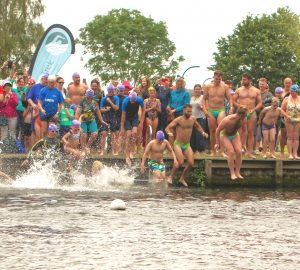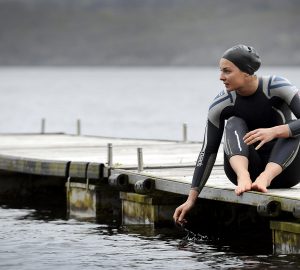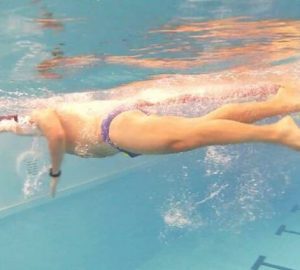How to become a better swimmer when you can’t go swimming
How to become a better swimmer when you can't go swimming
In my early 20s, I was told that I would never be able to walk or swim again, due to a serious illness. I didn’t realise at the time, that the six months I spent in hospital, unable to swim but thinking about it, would be so instrumental in getting back to the sport, let alone swimming better, faster and for longer as I got older. The experience taught me a huge amount about my body, how it works and how it responds to varying situations. It also showed me that a break from swimming, ironically, could be exactly what you need to become a better swimmer.
Many of the people I coach cram their swimming into busy lives. In the water, they focus on building endurance, working on speed and maybe doing an occasional stroke technique lesson. And, often, they see their swimming performance plateau or decline. Common reasons for this include poor technique that gets worse over time, tightening of key muscles due to over-use, and injury.
Most swimmers also understand that you can improve your swimming technique and reduce your risk of injury through improving your core strength, mobility and flexibility. The resultant benefits of being able to keep your body more aligned and swimming more naturally are key to speed and endurance. But we struggle to include core strength and flexibility training into our weekly routines.
Right now, we can’t swim, but we can use the time to work on those things that are important for good swimming but rarely prioritised. Instead of seeing lockdown and being out of the water as a disaster for your swimming, think of it, if you can, as a gift that will make you a better swimmer in the long term.
There are four key elements you should be working on during this time that can be built into a weekly programme.
- Endurance – Keep this ticking over with whatever you can do to maintain cardio fitness. Run, walk, bike or skip.
- Core Strength – Watch an elite swimmer and you’ll see that their body moves as a coordinated unit. You will only be able to swim like this if you take time to deliberately target and strengthen your core. How you do that, is up to you. It could be through swim-specific core exercises, Pilates or Barre exercises.
- Flexibility and mobility – You don’t need me to remind you how import these are nor, probably, how much most swimmers neglect working on them. There has never been a better time to take up yoga. I recommend “Swim Yogis”. Yoga instructors who also swim are worth their weight in gold.
- Visualisation – Back to that moment in hospital. It’s been proven in a number of scientific studies, that the power of visualising an activity on a regular basis can improve physical performance. Doing this in a regular, structured way (thinking of feel, sight, sound and smell) in a variety of imaginative swim locations will definitely help with your return to the water.
See below for additional relevant resources and video links
A training programme for swimmers who can't do any swimming at the moment
This is what I have recommended for the swimmers I regularly coach to work through on a weekly basis:
- Three endurance sessions of 30-60 minutes
- Three core sessions of 10-20 minutes
- Three (ideally swim-based) yoga sessions of 45-90 minutes
- Three virtual swims of 5-10 minutes each
Sample weekly programme
You can structure this however you like. For example, a week might look like:
- Monday: a.m. Run/jog/walk – 30 minutes; p.m. 10 minutes swim visualisation
- Tuesday: a.m. Yoga – 60 minutes; p.m. core workout – 15 minutes
- Wednesday: a.m – Swim visualisation – 10 minutes; p.m. rest
- Thursday: a.m. core workout – 15 minutes; p.m. bike ride – 60 minutes
- Friday: a.m. Yoga – 60 minutes; p.m. swim visualisation – 10 minutes
- Saturday: a.m. Core workout followed by run or cycle – 60 to 90 minutes
- Sunday: Yoga 60 minutes and rest
Try to introduce some new exercises each week to maintain variety
Why it will work
The fact is, if you get back to the water with a stronger core, improved mobility and flexibility, and have maintained your cardio endurance, you will be a better swimmer. Yes, the first few swims may feel a bit of a shock to the system and you will have lost your feel for the water. Your new improved all-round fitness may not immediately translate to the swim, but it will, and sooner than you think.
About Salim
Salim Ahmed has been a swimmer for the best part of 50 years, and a coach and instructor for at least 20 of those. He is the Resident Open Water Swimming coach at Shepperton Lake, runs the Kit Kat Swim Klub at Hampton, technique sessions in the SwimLab in Twickenham, and organises weekend clinics in Cornwall, Capri, and The Bay of Poets.
For more information or to speak to Salim about a programme to suit you, email salim@swimlab.org.uk
Find Salim on Instagram at salimswimlab
Additional resources
A 13-minute core strengthening exercise for swimmers
A 40 minute video class on improving your running technique, optimising efficiency and protecting yourself from injury while running.
Unique dedicated video yoga session for swimmers from a swimmer with Louisa, part of the SwimLab team.







